硕士学位论文
全桥 LLC 谐振变换器研究
RESEARCH ON FULL-BRIDGE LLC RESONANT
CONVERTER
黄贺
哈尔滨工业大学
2012 年 7 月
�
国内图书分类号:TM461.5 学校代码:10213
国际图书分类号:621.3 密级:公开
工学硕士学位论文
全桥 LLC 谐振变换器研究
硕 士 研 究 生:黄贺
导 师:贲洪奇 教授
申 请 学 位:工学硕士
学
科:电气工程
所 在 单 位:电气工程系
答 辩 日 期:2012 年 7 月
授予学位单位:哈尔滨工业大学
�
Classified Index: TM461.5
U.D.C: 621.3
Dissertation for the Master Degree in Engineering
RESEARCH ON FULL-BRIDGE LLC RESONANT
CONVERTER
Huang He
Prof. Ben Hongqi
Candidate:
Supervisor:
Academic Degree Applied for: Master of Engineering
Electrical Engineering
Speciality:
Department of
Affiliation:
Electrical Engineering
July, 2012
Date of Defence:
Degree-Conferring-Institution: Harbin Institute of Technology
�
哈尔滨工业大学工学硕士学位论文
摘 要
在大功率二次电源中,LLC 全桥变换器由于具备低应力,高效率,低电磁
辐射等诸多技术优势,成为了研究热点。但 LLC 变换器的工作特性、可靠性对
负载条件及工作频率所在区间较为敏感,在输入电压较低,负载由空载向满载
切换的过程中,若谐振腔参数设计不合理,变换器易出现容性开关现象,烧毁
变换器。
为提高全桥 LLC 变换器的可靠性,本文在对 LLC 变换器的基本工作原理
进行详细分析后,根据不同频率下的工作特性,将 LLC 变换器的工作频率区间
划分为三部分,而后分别对不同工作区间内变换器稳态工作过程中的各个阶段
进行详细描述。根据变换器结构特点进行简化分析后,得到全桥 LLC 变换器的
等效原理电路,对该等效电路建立基波近似(FHA)建模,依据此模型,在推导
出变换器的变压特性公式并做出曲线图后,详细的讨论了谐振腔参数对变换器
变压特性的影响。对变换器在容性工作区域内的各个稳态工作阶段进行详细讨
论后,找出了变换器的安全工作条件,进而推导出了谐振腔参数与该条件的关
系式。在对变换器效率问题进行讨论时,分别对开关管损耗以及整流二极管损
耗记性了详细的理论推导,得出了开关管损耗关于励磁电感量等参数的表达式,
找到了谐振参数与变换器效率的联系。为找出 LLC 变换器在负载突变过程中出
现暂态容性开通的具体工作机理,本文对变换器由轻载向重载切换时的工作过
程进行了详细讨论,而后得出变换器输出端等效电路,对其进行暂态分析并推
导出等效输出负载值的计算公式。以该公式作为参考,综合变换器软开关实现
的条件、谐振腔参数与变换器工作特性的关系等因素,找出一套全桥 LLC 谐振
变换器谐振腔参数的设计方法,达到提高变换器可靠性同时兼顾效率的目的。
根据本文所述的设计方法,设计一台输出为 48V/15A 的 LLC 全桥变换器,
使用 saber 对变换器参数进行仿真并制作了一台实验样机对理论进行了验证,
最终,实验结果证明了论文所提设计方法的可行性。
关键词:LLC;全桥;软开关;可靠性;效率
- I -
�
哈尔滨工业大学工学硕士学位论文
Abstract
Having
the advantages of
the
low stress, high efficiency and
low
electromagnetic radiation in high power DC/DC converter applying, full-bridge
LLC resonant converter has became a research hotspot. But the operating
characteristics and reliability of the LLC converter is very sensitive to the load
condition and
input voltage
circumstances,when load condition is changed from idle to full-load, the operating
frequency decreases rapidly, if the parameters of resonant cavity are not designed
properly, the converter will run in capacitive mode and burn down in the end.
frequency. Especially
the operating
in
low
In order to improve the reliability, the basic working principle of the
full-bridge LLC converter is analysed firstly, according to the intervals that the
working frequency of the converter lies in, the work phases of converter are
described in detail respectively. After simplifying the converter structure, the
principle circuit is obtained and a FHA model is constructed, with that model, a gain
formula is derived and a set of curves are drawn, then the influence of the cavity’s
parameter on gain features of the converter are analysed in details. After discussing
all the working stage of the converter in capacitive mode, the safe working
requirment of the LLC converter is found, then the relationship between that
requirment and the parameters of the resonant cavity is gained. In discussing the
efficiency of the converter, the loss of the swith and the rectifer diode is analysed in
detail, then the switch loss formula with respect to magnetizing inductnce is
obtained, finding out the relationship between the parameters of the resonant cavity
and the efficiency of the converter. Then, by discussing the processing that the load
conditon is changed from idle to full-load, the output equivalent circuit of the
converter is achived, by applying transient analysis on that circuit , the formula for
calculating the equivalent output load value is derived. Taking the formula as a
design consideration and combining the factors of requirement for soft-switching
implementation and the relationship between parameters of the resonant cavity and
operating characteristics of the converter,a set of design methods for full-bridge
LLC resonant converter resonator parameters is found to improve the reliablity of
converter whose efficiency is also taken into account.
According to the design method presented in this article, a 48V/15A LLC full
bridge converter is designed, by using the saber to simulate and producing an
experimental prototype,finally,theory is verfied.
Keywords: LLC, Full-bridge, Soft-switching, realibility,efficiency
- II -
�
哈尔滨工业大学工学硕士学位论文
目 录
摘 要 ...................................................................................................................... I
ABSTRACT ........................................................................................................... II
第 1 章 绪 论 ....................................................................................................... 1
1.1 课题背景与研究的目的和意义 ............................................................... 1
1.2 软开关技术发展概况介绍 ...................................................................... 2
1.2.1 零电压移相全桥变换技术 ...................................................................... 2
1.2.2 零电流移相全桥变换技术 ...................................................................... 3
1.2.3 有源箝位技术 ......................................................................................... 3
1.2.4 零电压零电流移相全桥变换技术 .......................................................... 4
1.2.5 LLC 谐振变换技术 ................................................................................. 5
1.3 本文的主要内容 ..................................................................................... 6
第 2 章 变换器稳态能量传输过程分析 ................................................................. 7
2.1 引言 ....................................................................................................... 7
2.2 变换器主电路拓扑结构 .......................................................................... 7
2.3 LLC 全桥变换器基本原理 ...................................................................... 8
2.4 LLC 全桥变换器稳态能量传输过程 ........................................................ 9
f 时变换器能量传输过程 .............................................................. 9
时变换器能量传输过程 ..................................................... 13
f 时变换器能量传输过程 ............................................................ 16
2.5 副端二极管零电流开关实现 ................................................................. 17
2.6 本章小结 ............................................................................................. 17
第 3 章 LLC 谐振腔参数与工作特性关系 .......................................................... 18
3.1 引言 ..................................................................................................... 18
3.2 LLC 全桥变换器基波近似模型 ............................................................. 18
3.3 LLC 全桥变换器增益与负载适应特性关系 ........................................... 20
3.4 LLC 全桥变换器安全工作条件 ............................................................. 23
3.5 LLC 全桥变换器效率特性与谐振腔参数关系 ....................................... 28
3.6 本章小结 ............................................................................................. 32
第 4 章 变换器参数设计方法讨论 ...................................................................... 33
4.1 引言 ..................................................................................................... 33
2.4.1
2.4.2
2.4.3
f
f
f
f
1
2
1
f
s
s
s
1
- III -
�
哈尔滨工业大学工学硕士学位论文
4.2 暂态容性开关问题 ............................................................................... 33
4.3 零电压开通实现条件 ........................................................................... 36
4.4 变换器谐振腔参数设计方法 ................................................................. 39
4.4.1 变换器额定工作点选择........................................................................ 39
4.4.2 确定参数 m ........................................................................................... 41
4.4.3 确定励磁电感量 Lm .............................................................................. 41
4.4.4 设计参数校验 ....................................................................................... 42
4.5 本章小结 ............................................................................................. 42
第 5 章 硬件电路设计及实验结果 ...................................................................... 44
5.1 引言 ..................................................................................................... 44
5.2 变换器电路参数计算 ............................................................................ 44
5.2.1 主电路参数选取 .................................................................................. 44
5.2.2 控制电路方案选择 .............................................................................. 46
5.2.3 变换器启动过程及启动电路参数计算 ............................................... 49
5.3 仿真结果 .............................................................................................. 51
5.4 实验结果 .............................................................................................. 53
5.5 本章小结 .............................................................................................. 56
结 论 ................................................................................................................... 57
参考文献 ............................................................................................................... 58
攻读硕士学位期间发表的论文及其它成果 ......................................................... 62
哈尔滨工业大学学位论文原创性声明及使用授权说明 ...................................... 63
致 谢 ................................................................................................................... 64
- IV -
�
哈尔滨工业大学工学硕士学位论文
第 1 章 绪 论
1.1 课题背景与研究的目的和意义
作为最清洁的二次能源,电能为人民的生活及社会经济发展提供最基本的
生活及生产资料,国际上已将电能的一次能源转转换率及占终端能源消费的比
重作为重要标准来衡量一个国家经济、科技、文化的发展水平。目前,我国电
能的一次能源转换率已接近 45%,与发达国家水平接近,但我国的电能利用效
率却仍落后发达国家 20 年,低下的电能利用率最终导致我国严重的“电荒现
象”,提高电能利用率已是迫在眉睫。
据不完全统计,超过 40%的电能是通过二次转换后才接入用电设备中的,
而在电能转换过程中,效率每提高 1%,那么全国每年就能节省 25 亿千瓦的电
能。传统的线性变换方式使用功率三极管进行电能变换,通过调整三极两端电
压对输出电压进行稳定,在工作过程中虽然 EMI 较小,但三极管一直处于放大
状态,电路损耗较大;受工频隔离变压器的影响,该类型的变换器体积很大。
随着用电设备不断向小型化,智能化方向发展,作为向这些设备供电的电能变
换器,面临着效率、性能等方面技术标准不断提高的处境。线性电能变换器方
式由于上述固有技术缺点,正被逐步被淘汰出各个应用领域。
近年来,电力电子技术飞速发展,以功率半导体器件为核心的开关电源技
术得到了广泛的使用。该技术有效地解决了在线性电源时代一直困扰人们的体
积问题,同时效率也有了大幅的提高,因此被越来越多的应用于航天、工业、
军事、IT 设备等各个领域,并代表了未来一段时间内电能变换技术的发展方向。
与线性电能变换方式不同,应用电力电子技术的电能变换器,其电路中的
半导体器件工作于开通和关断状态,因此功率管导通损耗显著减小,变换器效
率大幅增加,此外,通过提高工作频率,变换器的体积得到了有效控制,根据
法拉第定律可以得知,相同功率下,磁性元器件的体积与开关频率成反比,因
此,随着功率半导体器件技术的发展,开关电源技术的工作频率也由原来的几
十 kHz 逐渐提高到几百 kHz。但是随着开关频率的不断提高,开关电源技术又
面临着新的技术问题。首先,由于频率的提高,原本在总能量损耗中不占主要
份额的开关损耗变得不可忽视,该损耗还会随着频率的升高而不断增大,大大
降低了整个系统的效率。同时,由于开关损耗的增大,系统所需的散热元件体
积也不断增加,因此整个系统的体积与重量也受到了较大的限制。另一方面,
随着频率的升高,在开关开通关断瞬间的 di/dt 和 dv/dt 也会随之升高,这就会
- 1 -
�
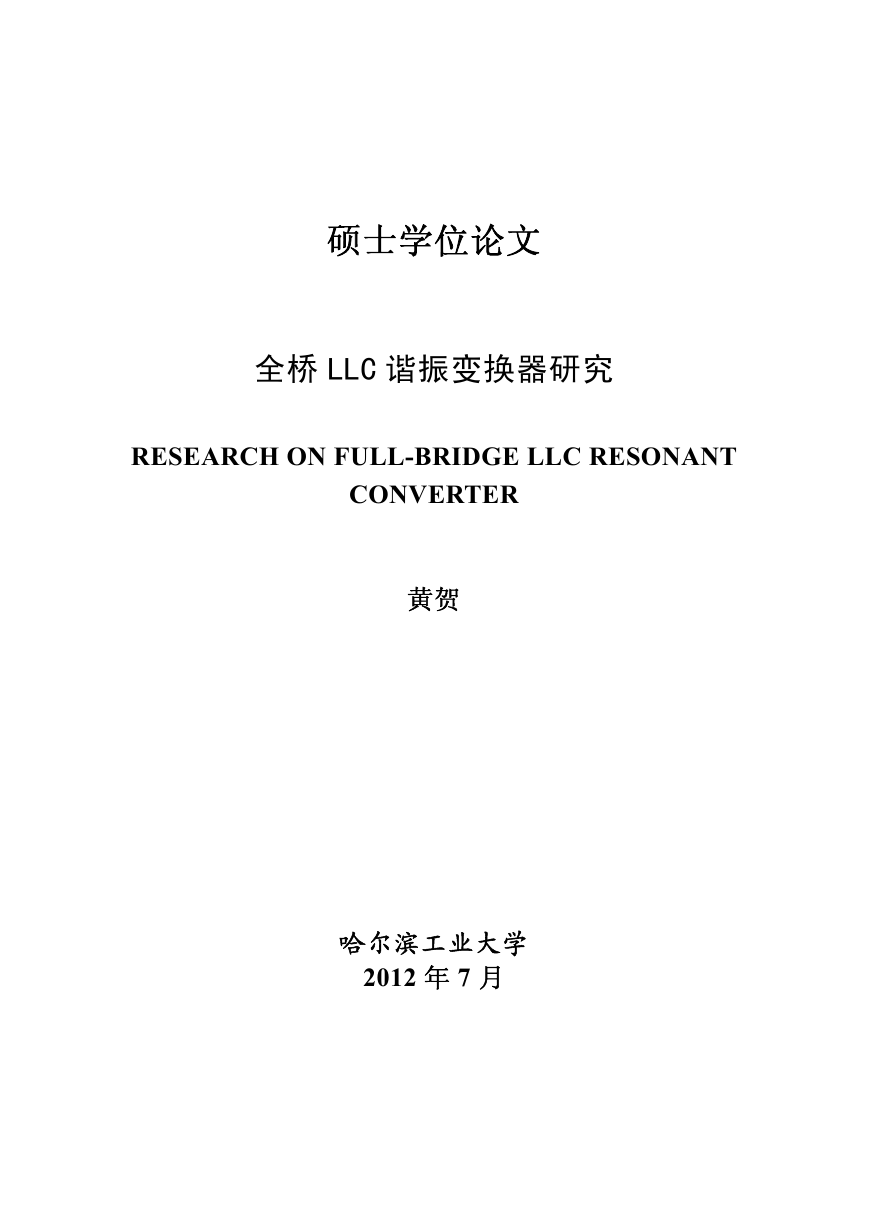

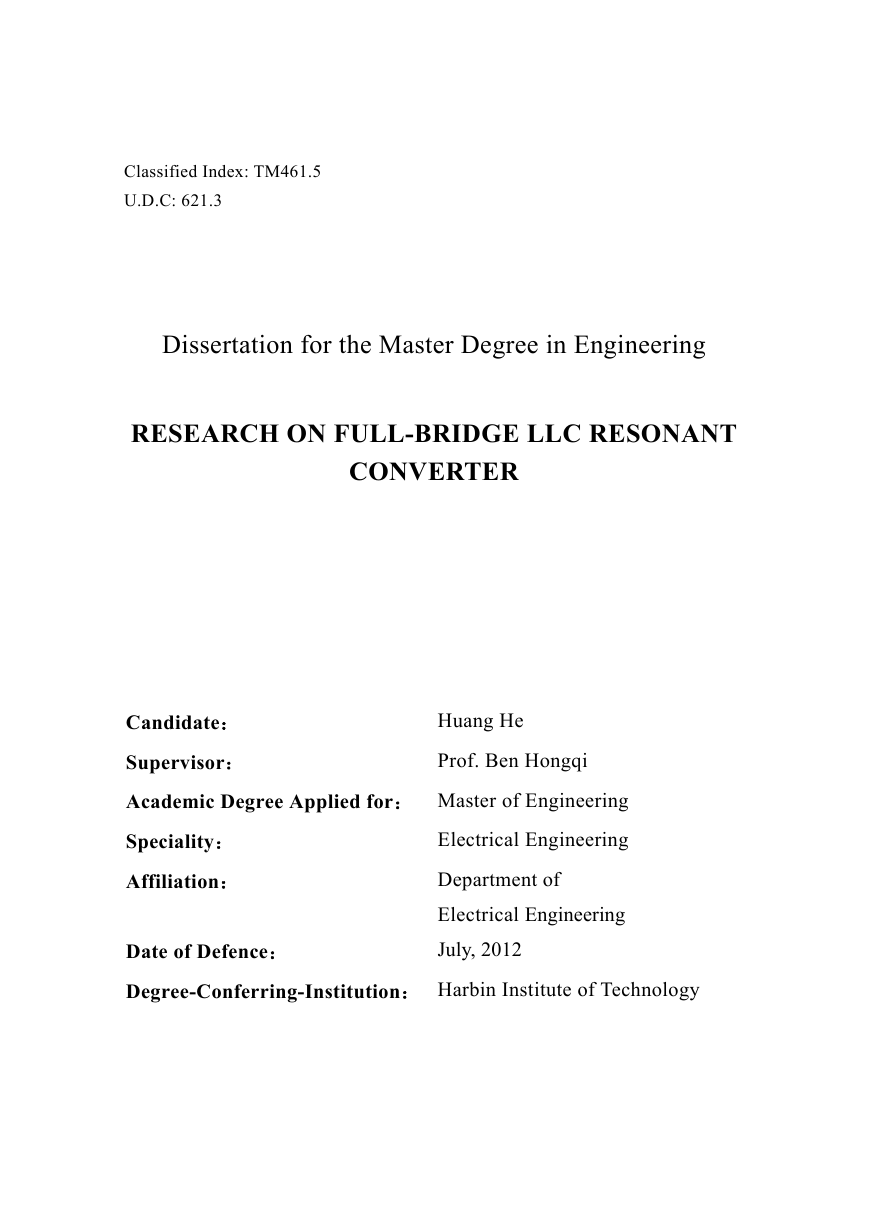

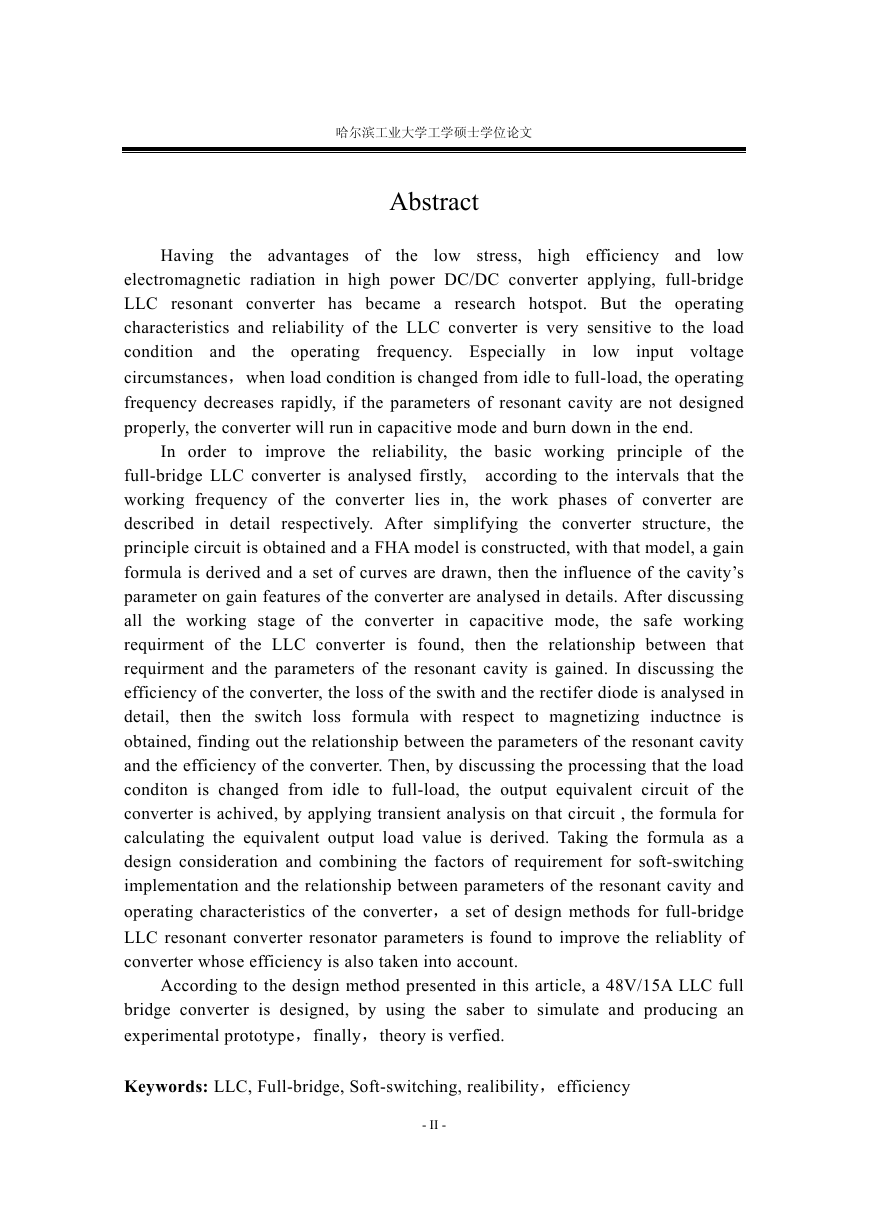
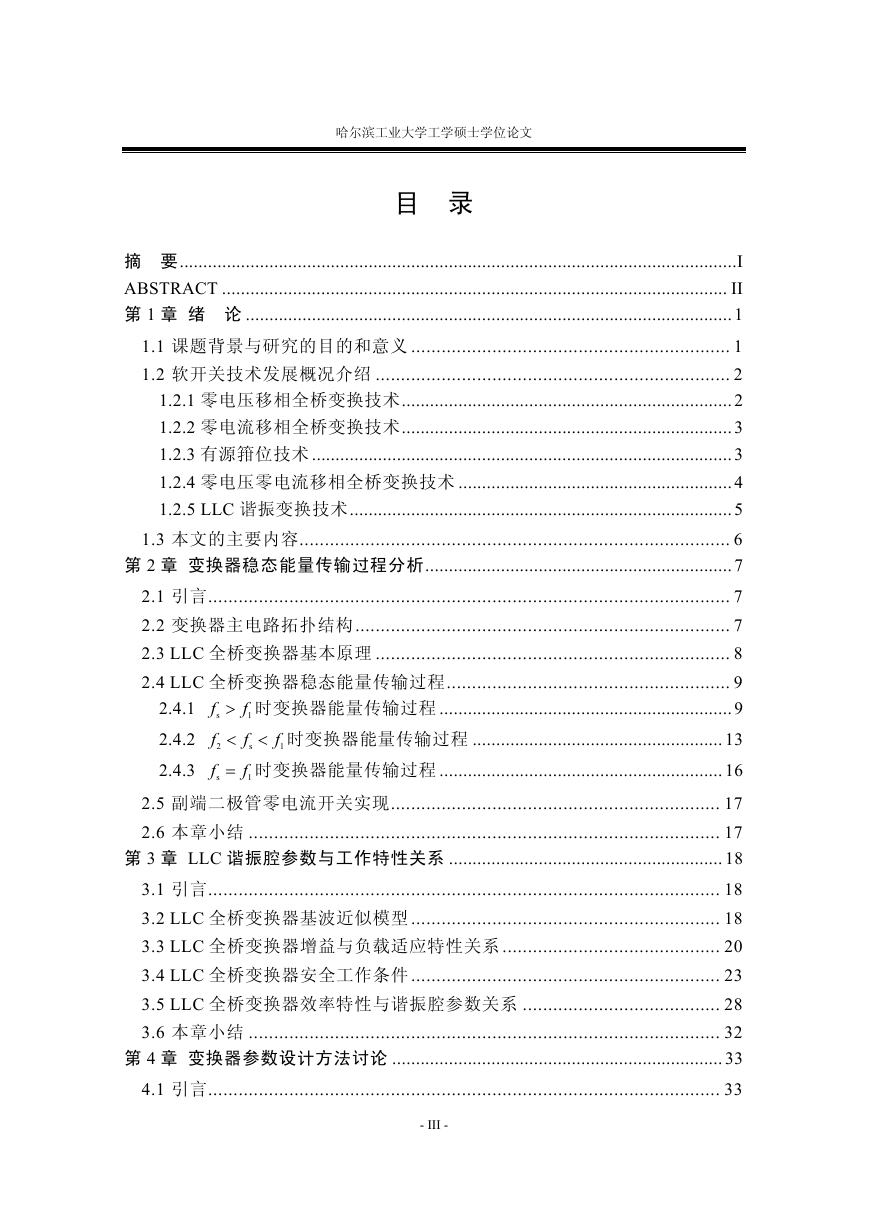
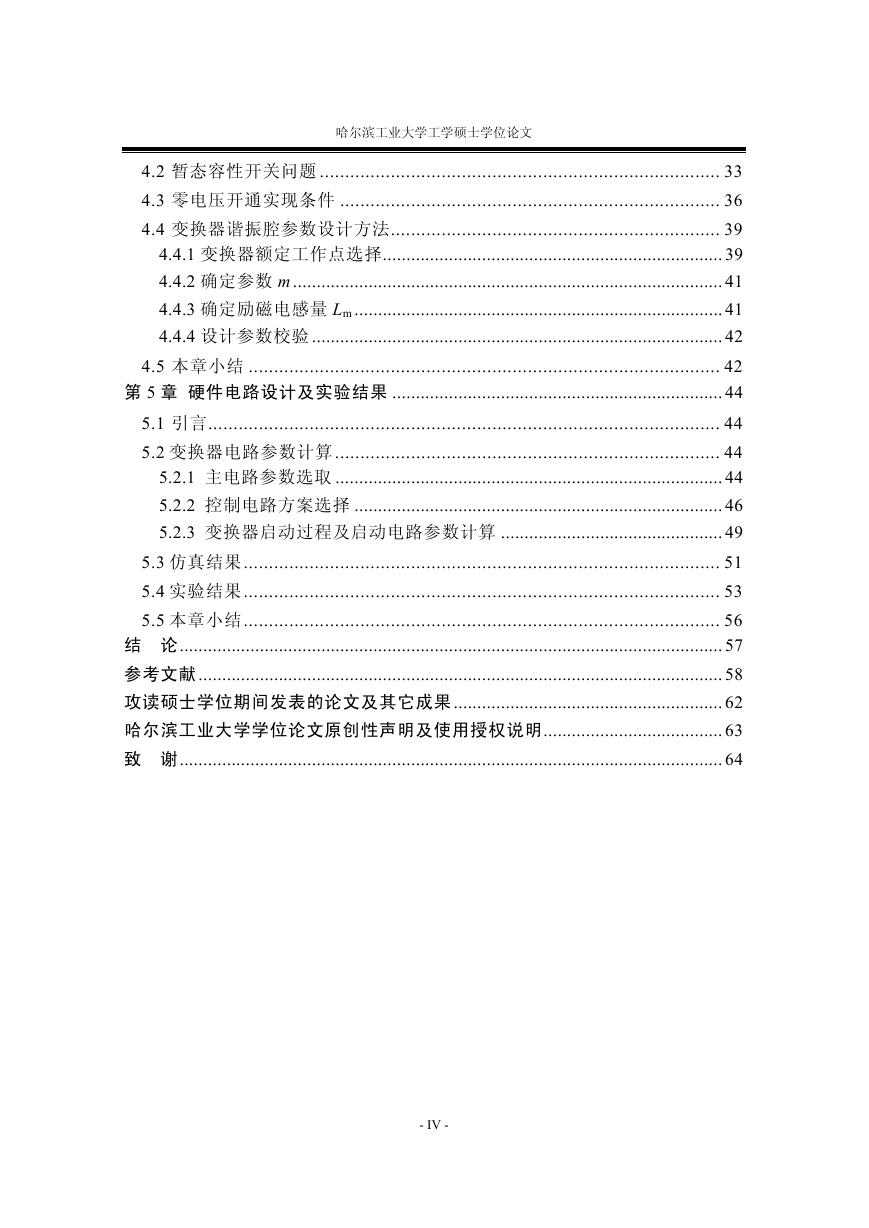
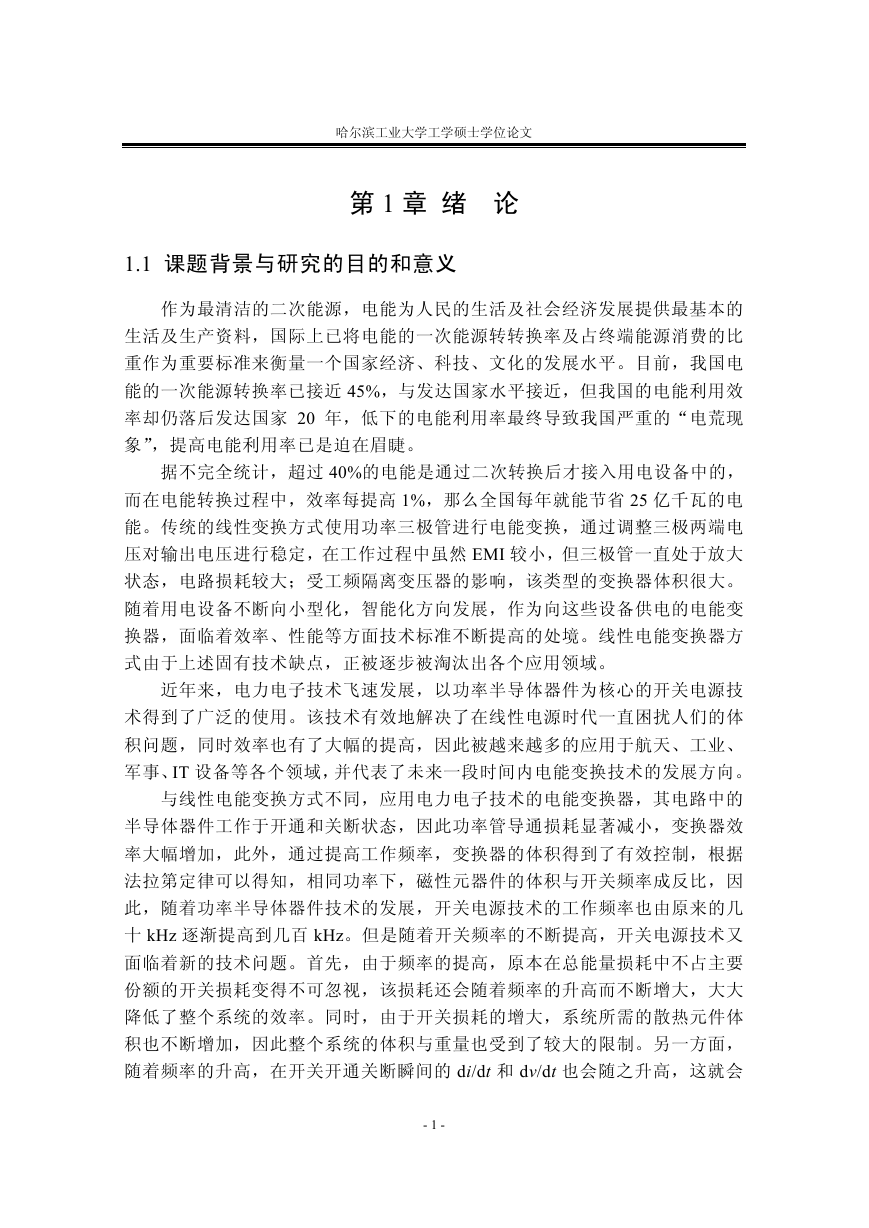








 2023年江西萍乡中考道德与法治真题及答案.doc
2023年江西萍乡中考道德与法治真题及答案.doc 2012年重庆南川中考生物真题及答案.doc
2012年重庆南川中考生物真题及答案.doc 2013年江西师范大学地理学综合及文艺理论基础考研真题.doc
2013年江西师范大学地理学综合及文艺理论基础考研真题.doc 2020年四川甘孜小升初语文真题及答案I卷.doc
2020年四川甘孜小升初语文真题及答案I卷.doc 2020年注册岩土工程师专业基础考试真题及答案.doc
2020年注册岩土工程师专业基础考试真题及答案.doc 2023-2024学年福建省厦门市九年级上学期数学月考试题及答案.doc
2023-2024学年福建省厦门市九年级上学期数学月考试题及答案.doc 2021-2022学年辽宁省沈阳市大东区九年级上学期语文期末试题及答案.doc
2021-2022学年辽宁省沈阳市大东区九年级上学期语文期末试题及答案.doc 2022-2023学年北京东城区初三第一学期物理期末试卷及答案.doc
2022-2023学年北京东城区初三第一学期物理期末试卷及答案.doc 2018上半年江西教师资格初中地理学科知识与教学能力真题及答案.doc
2018上半年江西教师资格初中地理学科知识与教学能力真题及答案.doc 2012年河北国家公务员申论考试真题及答案-省级.doc
2012年河北国家公务员申论考试真题及答案-省级.doc 2020-2021学年江苏省扬州市江都区邵樊片九年级上学期数学第一次质量检测试题及答案.doc
2020-2021学年江苏省扬州市江都区邵樊片九年级上学期数学第一次质量检测试题及答案.doc 2022下半年黑龙江教师资格证中学综合素质真题及答案.doc
2022下半年黑龙江教师资格证中学综合素质真题及答案.doc